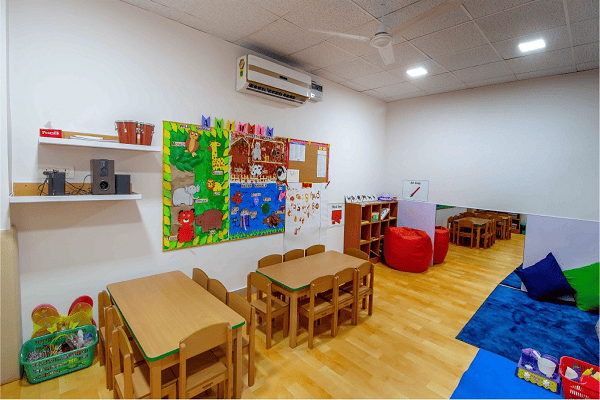Contents
Introduction
Day care is one of the greatest solutions for working parents who want to prepare their child for the future and commendable educational career ahead.
However, selecting an effective preschool has become a big challenge with the increasing number of institutions and educational formats for children.
Therefore, in this article, we have gathered a list of all the top qualities parents should look for in an institution to invest in their child’s day care.
Characteristics Of An Ideal Day Care

Given below are some of the most important characteristics that you must expect from good day care institutes—
1. Safety And Security
To encourage healthy growth and high self-esteem in children, create and maintain a secure atmosphere where they can study and explore without fear.
In early childhood education in preschool, accreditation is a large gold star because it means the program satisfies high requirements in every area, including safety, content, and instructor credentials.
The facility in which day care is provided must be safe and secure, with staff members educated in emergency procedures and the necessary safety precautions in place.
Also, performing regular safety audits to spot any risks and take immediate action is important.
Cover electrical outlets, keep harmful substances and medications out of children’s reach, and put breakable or dangerous items high up.
To keep children safe, fix, lock up, or remove anything that might pose a risk to them. Furthermore, make sure that any outside play spaces are fenced in.
2. Focused Attention
Sanchez suggests looking up standards for your region or asking prospective centers if they follow NAEYC ratios, which are often lower because staff-to-student ratio requirements vary from state to state.
The number of young students that each day care worker (or family child care provider) is in charge of watching after is known as the staff-to-child ratio.
According to federal law, each age group of children receiving care must meet specific requirements for child group sizes and staff-to-child (staff:child) ratios.
The employee-to-student ratio might shift from one staff member to 12 students as children age.
The staff-to-child ratio for family child care services should consider both the providers’ own under-six-year-old children and any other students who could be staying over temporarily and needing supervision.
A maximum staff-to-child ratio of 1:6 should be maintained in preschool facilities with mixed-age groups that include babies and toddlers, and no more than two of these children should be 24 months or younger.
3. Enhanced Sense Of Inclusivity And Diversity
Early childhood is the best moment to start highlighting the value of inclusion, equity, and diversity.
Children should be able to ask questions, share their experiences, and learn from one another in a safe and friendly setting.
In order to promote constructive conversations on diversity, equity, and inclusion, educators should work to build varied learning environments.
To develop a truly inclusive learning environment, teachers must actively endeavor to remove prejudices and preconceptions in both themselves and their students.
Youngsters as early as six months old start unconsciously classifying people into groups based on their race and gender, but by the time they are five years old, most children start to express a preference for peers of the same race.
Their teachers should encourage children to inquire about the many cultures, races, genders, and ethnicities they come across in the classroom.
Also read: 5 Education Lessons to Learn From Montessori Schools
4. Focus On Creativity
Every child is born with the ability to be creative. Still, parents and creche providers need to be more cautious in nurturing and encouraging this potential, or else it may be suppressed.
Children should have the chance to experiment and explore a variety of objects and concepts, and you should also try to get them to think beyond the box.
Teachers can learn about the child’s cognitive and emotional growth by seeing a preschool child engage in creative endeavors.
Also, promoting children’s creative expression can help them develop confidence and self-worth that can benefit their general well-being.
When a child’s ideas come to life and receive encouraging comments from their friends and instructors, engaging in creative activities may help boost their self-esteem and confidence.
Educators should support and foster children’s creativity in a play school to enhance holistic development.
Children may express themselves in wonderful ways via animal cracker games, continuous stories, imaginative theatrical play, and object-making.
5. High-Quality Curriculum
A thoughtful childcare curriculum should consider the fundamental information that day care children need and deserve, as well as how they learn best.
It should serve as a roadmap for teachers as they prepare for the following:
- Their lesson plans and educational offerings for the children.
- Ensuring that they are meeting their developmental needs.
- Fostering engaging interactions and a stimulating environment.
- Choosing the tools and supplies the play school child will use.
- Providing educators and parents with a common language to talk about their children’s growth.
A popular strategy for providing students with excellent early educational experiences is the emergent curriculum for day care facilities.
Early reading, numeracy, science, social-emotional skills, visual arts, music, dance, and dramatic play are some of the early learning ideas and pre-skills covered.
Exposure to books, spoken language, music, and repeating rhymes in a setting with plenty of print is necessary for early literacy development.
Numeracy entails interacting with various forms, sizes, colors, and patterns to develop numerical awareness.
Exploration of the senses, engineering, and scientific thought are all part of science. Learning about relationships, having fun, and making decisions is part of developing social-emotional abilities in preschool.
6. Quality Staff
Sanchez thinks that in order to guarantee that reliable employees are hired at the center, criminal background checks ought to be a prerequisite.
All instructors must be trained in early childhood education or a closely related subject and licensed in CPR and first aid.
Requirements change with the setting, state, employer, childcare worker education, and training.
As young children may not always comprehend what is proper, adults must exhibit patience, understanding, and calmness.
Young learners deserve care, kindness, and love when being taught. Instructors must be kind and sincere to win their respect and focus, organized to multitask and attend to conflicting requirements, and able to communicate their ideas clearly.
Teachers need to be passionate about the task and duty of instructing young students if they are to be effective.
7. Scope For Parents’ Involvement
Their families are the best educators, defenders, and nurturers of children’s growth and well-being.
According to research, youngsters who experience supportive parenting and active family involvement are likelier to excel in school, maintain better mental health, and acquire stronger social skills.
Prioritizing their role in supporting their children’s healthy development—including social-emotional and behavioral growth, school readiness, easing the transition to kindergarten, and supporting academic accomplishment in elementary school and beyond—is crucial for parents and families.
Also, educators and carers must collaborate with families to offer day care students the assistance they need to succeed academically and socially.
Parental participation and engagement are based on the values of mutual trust, constructive communication, and strong emotional ties.
According to research, parental involvement in their children’s education favors their conduct, attendance, and academic success.
Parental participation can deepen the bond between families and play schools and enhance the overall school environment.
8. Easily Comprehensible And Playful Learning Techniques
Early childhood education centered on child-led, unstructured play is known as “play-based learning.”
It aids in developing social skills, learning motivation, language and numeracy proficiency, initiative, focused attention, and worldly curiosity in youngsters.
Academic programs are teacher-led, where the instructor creates exercises or games to assist children in learning letters and distinguishing between shapes, sounds, and colors.
Play-based programs are child-centered, where children direct their learning using their curiosity and interests.
Play enables children to develop friendships, teamwork skills, a sense of self, and artistic expression in a play-based learning setting.
Although product-focused art is led by teacher-made examples and is based on instructions, process-focused art experiences have neither rules nor examples for the children to follow.
9. Learning Amidst The Nature
Daily outside time is crucial for play school children’s physical and emotional well-being. It improves brain connections and teaches them how to utilize their bodies.
Outdoor play offers these young students a sensory-rich environment that fosters their senses’ growth and enhances their general physical well-being.
Parents should encourage their children to play outside and partake in outdoor pursuits like bicycling, hiking, and environmental exploration.
Allowing them to experiment with developmentally appropriate risks gives them a chance to refine their own risk-taking techniques. Critical thinking abilities, self-awareness, and resilience are further advantages.
While striving to relax restrictions and engage in suitable risky play, it is crucial to remember that dangerous play was much more widely tolerated a few generations ago.
To achieve this, explaining safety precautions without making them seem frightening is critical.
When coming up with alternatives, it is important to be careful and use expressions that don’t restrict exploration.
An ideal day care must encourage children to spend every day outside, encourage small risks without placing undue pressure on children during their play school education, provide choices, and substitute “that’s not safe” or “that’s too high” with “do you feel safe?”




